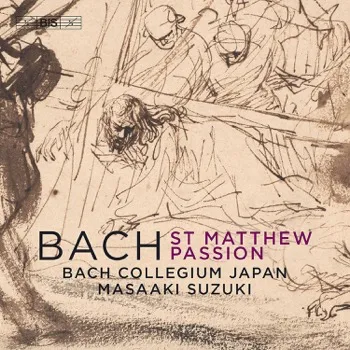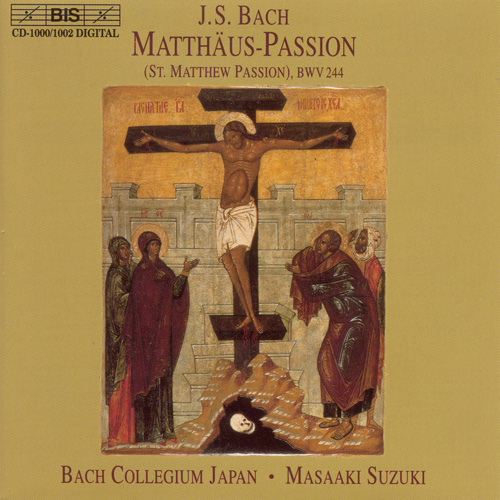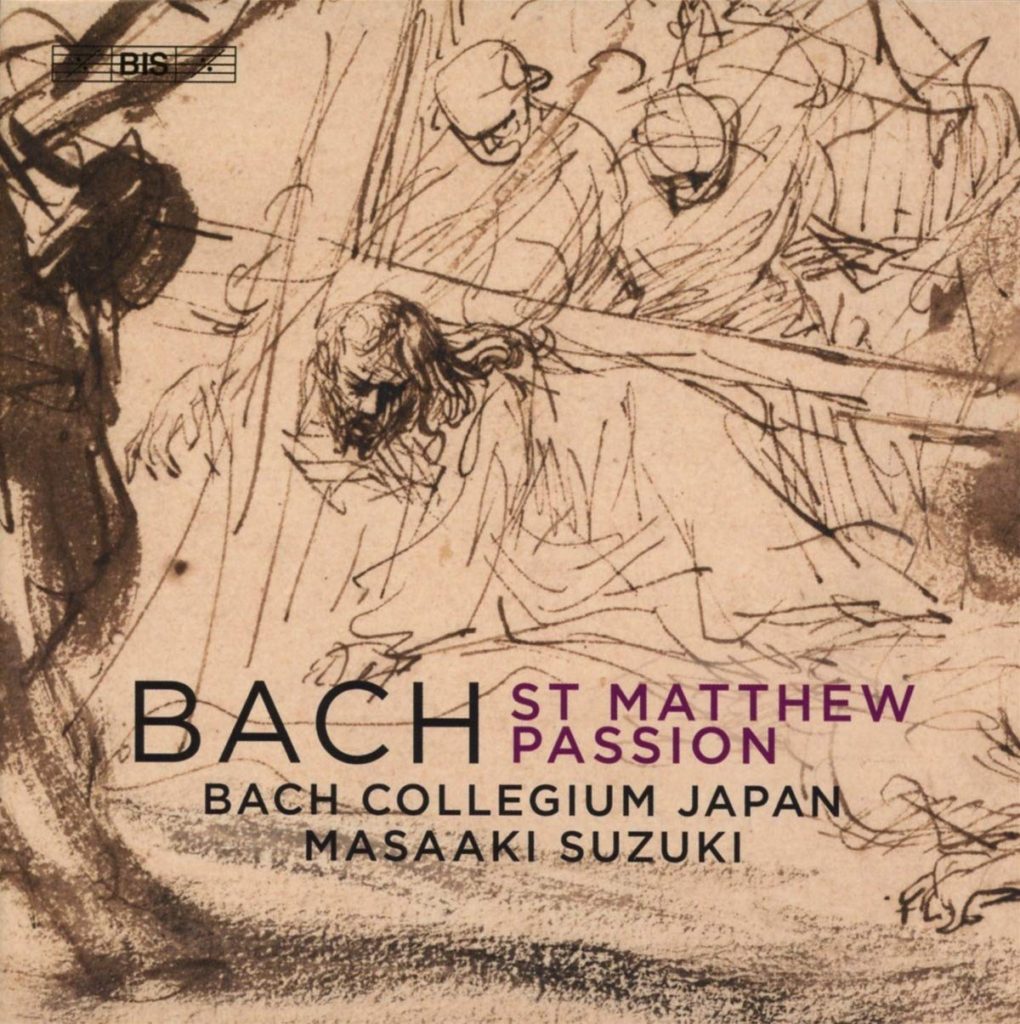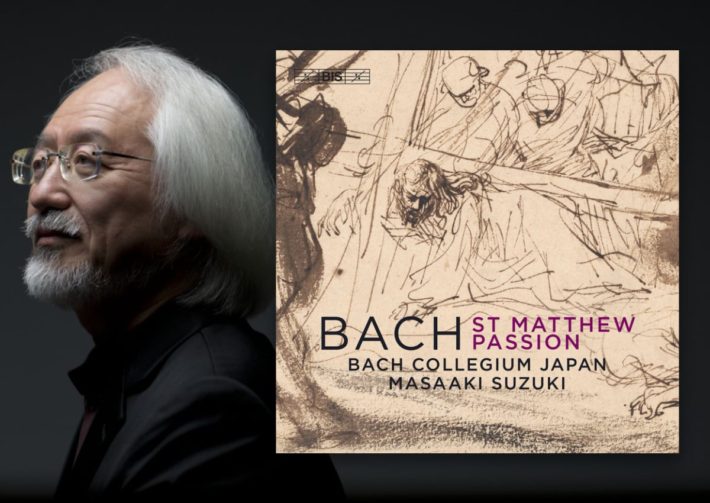The St. Matthew Passion was one of the first recordings the Bach Collegium Japan and Masaaki Suzuki made for BIS in 1999, with only a handful of volumes of the complete Cantatas under their belts. This 2019 recording marks 20 years for that recording, with the complete sacred and secular cantatas behind them, not to mention numerous recordings of other composers.

Those familiar with Suzuki and his Collegium will recognize their purity of sound and altogether high quality; as with all of their previous Passions and Cantatas recordings, each choir is comprised of 12 singers (soloists are joining the chorales), with uniformity of sound of each vocal group and the entire choir. Orchestral forces are also identical to previous efforts, the string sections of the two orchestras are made out of 10 members each, with the trademark luscious woodwind playing from oboes and flutes.
There are few differences from the 1999 recording, however. One is the recording, which is more detailed and close, allowing us to better enjoy Bach’s often overlooked orchestral polyphonies. The accompanying organ in the recitatives is more prominent (though not as elaborate as Koopman or Jacobs’) and there is an added harpsichord in big crowd scenes and arias, which Suzuki successfully incorporated in his Johannes-Passion recording but not in his early St. Matthew.
The St. Matthew Passion is a tough piece to pull off. Each element needs to be dealt with carefully – The opening and closing choruses, the soloists’ arias, the chorales and the recitatives, which take us through the story. And after all is said and done, all of these elements must fuse into a coherent whole. Not many conductors succeeded in making each element work successfully, and even less to work as a whole. In general, there is a cohesiveness just because of Suzuki’s approach to Bach; everything flows naturally and save for few questionable decisions (which we’ll get to later), Suzuki doesn’t do anything to prevent the music from speaking for itself.
That being said, some listeners may wish for additional drama or interest. With the Bach Collegium Japan, Bach looks Back to the Passions of composers who came before him, an approach eloquently discussed in the informative booklet essay by Robin A. Leaver. Where Bach looks ahead with his dramatic crowd scenes, involving recitatives and the almost unprecedented dissonances in the orchestral accompaniment, turn to Harnoncourt’s last version (2001). There you’ll get less polished chorale and orchestral executions, but a much more captivating narrative.
This tension between a polished execution and an effective expression can be found in the recitatives and arias. Benjamin Bruns takes the difficult role of Evangelist, doing a fine job communicating the story. Yet Gerd Türk from the 1999 version was more involved, if less meticulous. Both Bruns and Bass Christian Immler, who takes on the role of Jesus, are a good match in their joined recitatives, but I could have lived with a more discernible vibrato from both. One must also admit that Immler, a fine and deep-voiced Jesus, is no match to the ravishing Peter Kooy in the 1999 recording, one of the highlights of the older version. From the arias soloists, Soprano Carolyn Sampson is one of the stars of this recording, proving once again that she can sing convincingly practically any repertoire, as we’ve observed on previous reviews.


Old Vs. New St. Matthew Passion by Suzuki
The final scenes of the Passion, that somehow lost tension in the 1999 rendition, is more poignant here, the evangelist and crowed, added by the more prominent orchestra and organ, deliver the text more persuasively and manage to retain tension without losing any of the spirituality. The chorales, however, are overly deliberate, with every word thoroughly considered, making them more declaratory than contemplative – Listen, for instance, to “Wer hat dich so geschlagen” (CD 2, Track 2), which is overly excited and emphasizes what Suzuki considers as words worth highlighting. I for one would have liked the music to speak for itself here, as Herreweghe, Koopman or Jeffrey Thomas do. There is also some predictability in the phrasing of the choir’s higher voices, with every long phrase matches the small crescendo made by the baroque bows (a habit many fellow period instruments performances adopt).
All in all, fans of Suzuki and the Bach Collegium Japan will know what to expect, and will surely want to purchase this new set as a testament to the maestro’s latest thoughts on the passion, 20 years after his first recording and the added experience of performing the entirety of Bach’s choral works. For a comparison of different approaches to this baroque masterpiece, try Harnoncourt’s almost operatic version, Herreweghe’s second take with his Collegium Vocale Gent and Ian Bostridge as an impressive evangelist, Koopman’s two versions and René Jacobs for the sophisticated continuo accompaniment and storytelling. Also worth examining is Frans Brüggen’s mediocrely recorded but superbly performed solo arias.
Bach – St. Matthew Passion
Benjamin Bruns – Evangelist
Carolyn Sampson – soprano I
Aki Matsui – soprano II
Damien Guillon – alto I
Clint van der Linde – alto II
Makoto Sakurada – tenor I
Zachary Wilder – tenor II
Christian Immler – bass I — Jesus
Toru Kaku bass II – Judas, Pilate, High Priest, Chief Priest
Bach Collegium Japan
Masaaki Suzuki – Conductor
Bis Records, Hybrid SACD BIS-2500




















